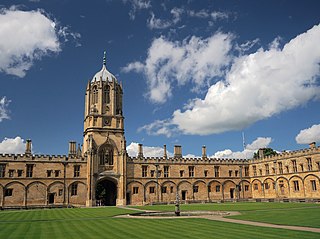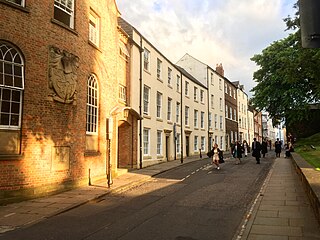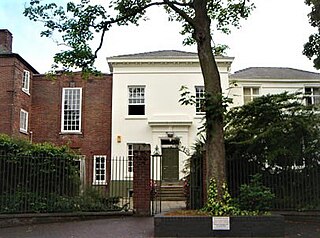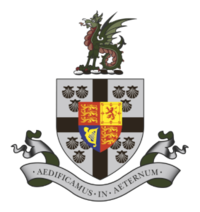
Christ Church is a constituent college of the University of Oxford in England. Founded in 1546 by King Henry VIII, the college is uniquely a joint foundation of the university and the cathedral of the Oxford diocese, Christ Church Cathedral, which also serves as the college chapel and whose dean is ex officio the college head.

Trinity Hall is a constituent college of the University of Cambridge.

Queens' College is a constituent college of the University of Cambridge. Queens' is one of the 16 "old colleges" of the university, founded in 1448 by Margaret of Anjou. Its buildings span the River Cam with the Mathematical Bridge and Silver Street connecting the two sides.

St Chad's College is a recognised (independent) college of the University of Durham. Founded in 1904 by Stephen Moulsdale as St Chad’s Hall, where it served until 1971 an Anglican hall for the training of Church of England clergy, and today as residence and guilds of students who reads for a degree at the University of Durham. Its library system is amongst Durham's largest collegiate libraries. St Chad’s performs exceptionally within Durham where 90% of its students attained a first or upper second class honours.

Ormond College is one of the largest residential colleges of the University of Melbourne located in the city of Melbourne, Victoria, Australia. It is home to around 350 undergraduates, 90 graduates and 35 professorial and academic residents.

New College, University of New South Wales is a residential college, located in the UNSW campus in Sydney. The college is organised around on Anglican principles. About 250 undergraduate students, both local and international and of a variety of backgrounds, live in the original college building, and 315 graduate students are housed in the nearby New College Village. New College is also home to the Centre for Christian Apologetics, Scholarship and Education (CASE) which specialises in Christian apologetics.

Sir John Clifford Valentine Behan, the first Rhodes Scholar from the state of Victoria, was an Australian educationalist and lawyer, the second warden of Trinity College at the University of Melbourne, and "beyond the college life [at Trinity,] he was a sound and far-seeing secretary in Australia of the Rhodes Scholarship Trust for 30 years from 1922 to 1952".

St Mark's College is a university co-residential college in North Adelaide, South Australia. Founded in 1925, it is affiliated with the Anglican Church of Australia. It is the oldest residential college in South Australia and is associated with the University of Adelaide, the University of South Australia and Flinders University. Located next to St Peter's Cathedral on Pennington Terrace, the college houses 245 tertiary students in both dormitory and apartment accommodation.

Newman College is an Australian Roman Catholic co-educational residential college affiliated with the University of Melbourne. It houses about 220 undergraduate students and about 80 postgraduate students and tutors.
Edward Holdsworth Sugden was the first master of Queen's College. He was, in partnership with the Methodist Church, responsible for laying down the foundings of the college including the Sugden Principle.

St John's College, or the College of St John the Evangelist, is a residential college within the University of Sydney.

St Hilda's College is a college of The University of Melbourne, providing a residential community for students from all parts of regional Victoria, interstate and overseas. It provides accommodation, academic and pastoral support for 240 undergraduate students. In addition to the students, St Hilda's College also houses a number of senior residential advisors and other staff. The college mascot is Diego the Dinosaur.

The Vanderbilt Divinity School and Graduate Department of Religion is an interdenominational divinity school at Vanderbilt University, a major research university located in Nashville, Tennessee. It is one of only six university-based schools of religion in the United States without a denominational affiliation that service primarily mainline Protestantism.

St Anselm Hall, known colloquially as Selms, is a traditional University of Manchester hall of residence situated in Victoria Park.

The United Theological College located in Aberystwyth, in the county of Ceredigion in mid Wales, is a Grade II listed building which was the ministerial training college of the Presbyterian Church of Wales from 1906 to 2003 and an associate college of the University of Wales.

Philip Ridgway "Pip" Le Couteur was an Australian academic, philosopher and headmaster.
Lawrence Richard Dimond Pyke was an Australian headmaster and university dean. Referred to in print as LRD Pyke, this led to his nickname of "Lardy".

Wesley College is a co-residential college of 265 students within the University of Sydney. The college occupies a site on the main campus of the University of Sydney and was built on a sub-grant of Crown land. Wesley is one of six on-campus colleges at the University of Sydney which provide accommodation. In 1923 the college averaged 45 students. Originally the college accommodated only men but when women were admitted in 1969 Wesley became the first of the colleges within the University of Sydney to become co-educational. Its current head is Lisa Sutherland, who has held the position since 2010.

Jesus College is a constituent college of the University of Cambridge. The college's full name is The College of the Blessed Virgin Mary, Saint John the Evangelist and the glorious Virgin Saint Radegund, near Cambridge. Its common name comes from the name of its chapel, Jesus Chapel.























